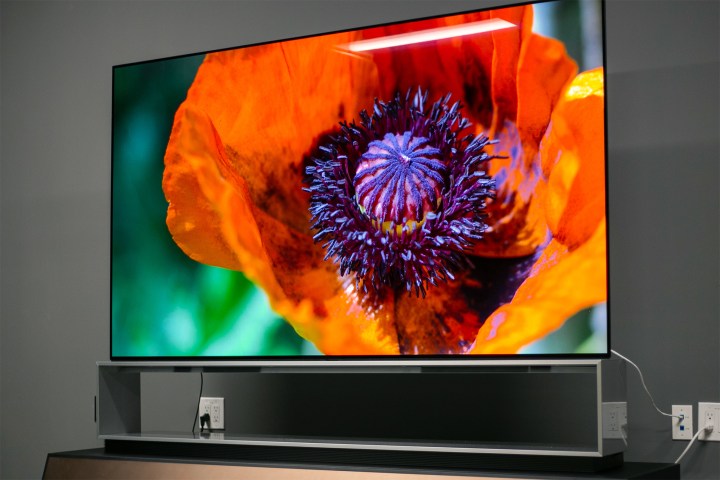One of the best parts of CES is getting a chance to hear from the companies behind the products we buy. A case in point is LG. Technically speaking, even though we buy LG OLED TVs from LG Electronics (LGE), the OLED panels inside those TV are engineered and manufactured by LG Display (LGD), a close, but separate division within the massive LG mothership. And LG Display is using CES 2021 to introduce a dizzying array of OLED innovations, from tiny, 20-inch TVs, to transparent panels that sit at the foot of your bed, to gaming displays that bend at the touch of a button.
Here’s why 2021 is going to be the biggest OLED year so far …
From small to super-sized

Browse the TV section of any big box or online retailer and you’re bound to find OLED TVs from Sony, LG, and Vizio in 55- and 65-inch sizes. Dig a little deeper and you’ll find models in the 77-, 88-, and 48-inches sizes too. These are the meat and potatoes of the OLED TV world at the moment. But these sizes are just the tip of the OLED iceberg.
LG Display has plans for many more sizes. Variations on existing sizes will be 83-inch and 42-inch OLED panels, but there will also be much smaller ones “down to the 20-30-inch range,” according to an LGD press release. These tiny panels will be geared toward gaming, mobility, and personal display options.
Additional sizes of OLED displays are obviously beneficial when it comes to developing new TVs and other products, but there’s another reason why we’re beginning to see this increased variety. OLED displays aren’t created individually. At least, not anymore. They’re actually cut from a much larger mother sheet of OLED glass. One of these mother sheets is big enough to yield two 77-inch panels, but when you do that, there’s still quite a lot of material leftover — just not enough for a third or fourth panel of that size. But it is enough to yield two more panels at 48-inches each.
If you can sell these 48-inch panels, you’ve just massively increased yield and profitability while simultaneously reducing waste.
Gamers get bent

We tend to buy OLED TVs that are big, rigid affairs, but OLED technology has always been capable of assuming a flexible form. LG has shown off this capability at previous CES shows with both roll-up and roll-down OLED TVs. But what if, instead of using OLED’s flexibility to hide it away when not in use, we used it to morph a screen from flat to curved and back again, all at the push of a button?
That’s the premise behind LGD’s 48-inch Bendable Cinematic Sound OLED TV, a first-of-its-kind that the company is showing at CES this year. The prototype gaming-centric TV sits on a pedestal that doubles as Qi wireless charger and has a small button that is used to trigger the transformation between flat and curved.
Curved OLED TVs aren’t new — some of the first OLED models featured a slight curve — but being able to choose a more immersive, curved display while gaming while retaining the ability to flat for movies and shows is a definite innovation.
Another innovation is LG’s Cinematic Sound OLED (CSO) technology which turns the entire OLED display into a speaker. LG isn’t the first to use this kind of technology — Sony introduced it on its Master Series OLED in 2019 under the name Acoustic Surface Audio+ — but it’s the first time we’ve seen it on such a small screen.
See-through TV

LGD is also using CES 2021 to showcase what you can do with OLED’s inherent ability to be transparent. One demonstration puts a transparent OLED display at the foot of a bed, inside a motorized frame that can lift the OLED display to its full height, or drop it down to any other level including fully recessed. Each height can be used to display different content from a simple clock to a detailed weather report.
Another example is the use of transparent OLED displays in restaurants to create versatile information screens that don’t add heaviness or block light.
A third example is a transparent OLED screen mounted in front of the window of a subway car. It can show route maps, weather, news, and advertising, without blocking the window’s view of the outside world.
LGD’s transparent OLEDs are 40% transparent and use the same CSO audio system as the bendable gaming TV so there’s no need for a separate speaker system.
A healthier display
LG has touted the many benefits of OLED displays over the years but it’s using CES 2021 to remind people that those benefits can expand to one’s personal health, too. LG Display’s OLED products have acquired certifications for low blue light emissions and flicker-free status from Germany’s TUV Rheinland and the U.S.-based safety agency UL (Underwriters Laboratories). By lowering the amount of blue light to the lowest level in the industry, the company has also obtained the “Eye-safe TV” certification from Eyesafe, an American eye health certification body, according to LGD’s press release.
LGD makes the highly relevant point that especially during a pandemic, when we are in front of our screens even more than normal, the quality of the display matters.





